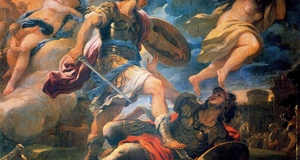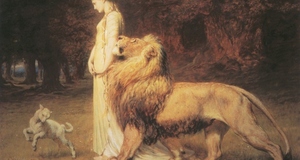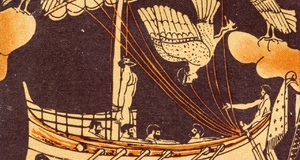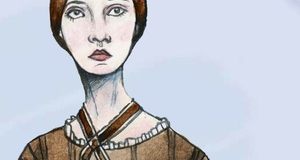|
From Discussions VOL. 5 NO. 2 Four Lines to Immortality: Dido's Renaissance Through Josquin des Prez
The final cadence is particularly striking. The piece ends on a Phrygian cadence while the other cadences of the piece are predominantly in Dorian. The 2-1 motion of the bass lacks the strength of a 5-1, and the soprano does not rest on the final note of G, but ascends in the second half of the bar to a B. This rise gives the final measure an open-ended sound, and the ascending note contrasts with the numerous descending figures that appear before it. The last note gives a sense of ambiguity to what should be the final resolution. Because it follows a piece characterized by calm pride, this last measure's uncertainty lends a subtle drama to Dido's plight. The open-ended nature implies questions without answers, life without understanding, death without resolution.
Despite Josquin's frequent use of imitation and repetition (particularly in the first two lines of the poem), the four voices are rarely more than a measure apart in their declamation of the text. Often, the ends of poetic lines are clearly marked with long note values, and other voices begin the imitation anew over the previously held note. A good example is in the middle of the first line of text. In m.8 of Bernard Thomas's edition of the piece11, the soprano line holds a G on the "ae" of "exuviae" for the length of a double whole note while the other three voices move on to "dum fata" in half and quarter notes.
A particularly striking entrance occurs in the second line of poetry, on "accipite hanc," where Dido implores death to receive her life. The rhythm seems to fit the word particularly well; "accipite" is declaimed on a half note, two quarter notes, and another half note in m. 15, and carried through all four voices. It is an interesting contrast from the long values of the first entrance on "dulces," which is written mostly in whole notes and double whole notes. The alto and bass lines declaim the text together on this striking rhythm. This effect is imitated in m. 30, where the soprano and tenor lines have the same eighth-note rhythm on "peregi." This echoes the previous settings of "accipite" in the other two voices, and shows Josquin's attention to vocal groupings. His setting of Dulces exuviae may not be chordal, but he is by no means ignorant of the vertical interaction of his vocal lines. His attention to rhythmic affect is a source of beauty in the music.
No voice sings the exact poem in its unadulterated form. Each voice has repetitions of words or entire phrases. Other settings of the text assign the entire poem in at least one voice.12 De Orto chooses to place the pure line in the soprano, and the anonymous setting from the Bernard Thomas edition places the unadorned version in the tenor. This lack of an untouched line in Josquin highlights certain words of the text.
One such word is "cursum" (mm. 25-28). All four voices have overlapping melismas13 on this word, which means "course" or "journey." This is a vivid example of text painting, as the winding lines imply the winding course of the life Dido has lived. A melisma is a musical journey, and a fitting device for demonstrating the difficult path Dido has had to travel. Josquin's voices each have unique patterns of repetition. Whether these repetitions were simply for vertical alignment or for word emphasis, they give weight to certain words of the short text. The soprano, for example, repeats the words "dulces exuviae" and "sinebat" twice each, emphasizing the belongings that represent the last vestige of her lover and an active memory of the past. "Sinebat" is in the imperfect tense, a tense for habitual past action. She is reflecting on the items Aeneas left behind, and the brevity of her affair "sweet to me while fate and god allowed" with the future founder of Rome (trans. Coulton).
The alto also focuses on the introductory material of the poem. The line repeats "dulces exuviae" (sweet relics) twice, "dum fata" (while Fate) three times, "deusque" (and God) twice, and "curis" (woes) twice. The "dulces exuviae," "dum fata," and "deusque" are all extracted from the first line of the poem. The second voice emphasizes the two forces that caused Dido's love of Aeneas: "fata" (Fate) and "deusque" (and God). The alto becomes slightly mournful in its repetition of "curis" (woes). The alto emphasizes the queen's wish for release from earthly anguish. The bass line repeats "exuviae" twice and "dum fata" twice. This pattern, coupled with the voices above it, shows a stronger sense of repetition in the beginning of the poem more traditional declamation at the end. The second, third, and first half of the fourth poetic lines rely more on melismatic material than on simple repetition.
One of the most arresting aspects of the piece is Josquin's treatment of the final words "sub terras ibit imago" (I will go beneath the Earth, line 654). The soprano repeats "sub terras ibit imago" three times, followed by two repetitions of the "ibit imago," which gives the sensation of fading into her accepted fate (mm. 34-43). The alto repeats "sub terras ibit imago" twice, followed by four repetitions of "ibit imago," which reinforces the feeling of the soprano (mm. 33-43). The tenor line is an even weaker echo; it does not repeat the whole phrase but begins with three repetitions of the "ibit imago" and fades to four repetitions of the "imago" (mm. 34-43).
The bass makes its most adamant word repetitions at the end of the motet. Copied exactly from the Bernard Thomas edition (mm. 32-43), it reads: "sub terras, sub terras, sub terras ibit, sub terras ibit imago, sub terras ibit imago, ibit imago." The bass has the most repetitions of the phrase, begins the line the earliest, and sings it in the lowest range. The effect of the bass' repetition pattern is to cause suspense. The full line is not revealed until its fourth iteration in mm. 37-39. There is a sense of reluctance in its unwillingness to provide the entire text at first. It undermines Dido's resolve. Perhaps there is a twinge of doubt. Perhaps she is slightly afraid of her death and is stuttering to get the words out. This phrase echoes again and again in the voices, the way it might sound in a cave if spoken aloud. The repetition and descending note patterns enforce the finality of Dido's words as she announces her death. Whether or not the queen is afraid to die, she has decided to do so, and this fitting close to the motet reflects her persistence. Perhaps the repetitions are a source of strength; a method of steeling herself for her encounter with Aeneas' sword.
Josquin's Dulces Exuviae does not clutter the text with over-wrought counterpoint14. The spare quality to the echoed interactions between lines is quite arresting. The voices move with such calculated intervals through the text that one hears Josquin's emotional interpretation of the classical text. Dido's words gain a quietly haunting quality through this motet that can only be fully realized through performance. There is a slow, stately feeling to the piece, even when note values diminish from double-whole notes to eighth notes. There is a sense of broadening calm and contemplation. Dido's words are expressed with the grace of one of the finest composers of the Renaissance.
Josquin may never have chosen to set Dido's speech had Virgil's poetry not been such a ubiquitous teaching tool for the Latin language. Classical poetry was the gateway to the Latin of the Church. The use of the great Roman epics in the classroom provided a venerable canon of works, along with the liturgy, that could serve as an acceptable source of artistic inspiration for Renaissance composers. The study of these epics alongside Biblical texts legitimized their allegorical connection to the liturgical works. However, Virgil's rebirth in the classroom was fueled not only by the strength of his poetry, but also by others viewing him as a prophet of Christ.Continued on Next Page »
Crane, Gregory R. (ed.) The Perseus Project, http://www.perseus.tufts.edu, February, 2008.
Dryden, John, translated. The Aeneid. http://www.perseus.tufts.edu, February, 2008.
Edgeworth, R.J. "The Death of Dido," The Classical Journal, 72.2 (Dec. 1976-Jan 1970): 129-133.
Guentner, Francis J. "Dulces exuviae in Sixteenth Century Music," The Classical Journal, 68.1 (Oct.-Nov., 1972): 62-67.
Holford-Strevens, Leofranc. "'Her Eyes Became Two Spouts': Classical Antecedents of Renaissance Laments," Early Music 27.3 , Laments (August 1999): 379-393.
Hollander, Robert. Expanded version of the article "Virgil." Dante Encyclopedia. Ed. Richard Lansing. New York: Garland Publishing, Inc, 2000.
Huelgas Ensemble dir. Paul van Nevel. Josquin des Prez. "Dulces Exuviae." Le Chant de Virgile. Harmonia Mundi Fr., 2001.
Hunter, James m. "Ovid Heroides VII" An Ongoing Translation of Ovid's Heroides. 31 October 2008.
MacKail, J.W. (translated) The Eclogues of Vergil. http://www.sacredtexts.com/cla/virgil/ecl/index.htm, March, 2008. "Motet." The Harvard Dictionary of Music. Ed. Don Michael Randel. 4th ed. Cambridge, Massachusetts and London,
England: The Belknap Press of Harvard University Press, 2003.
MOTET online database. Dr. Jennifer Thomas. Revised May 10th, 2008. Univeristy of Florida. May 18th, 2008. http:// www.arts.ufl.edu/motet/default.asp
"Motet." The Oxford Dictionary of Music, 2nd ed. rev. Ed. Michael Kennedy. Oxford Music Online. 16 Mar. 2009 .
Ovid. "Epistulae Heroidum: VII Dido Aeneae." The Latin Library. Posted by David J. Califf from an original edition. 31 October 2008.
Schmalfeldt, Janet. "In Search of Dido," The Journal of Musicology, 18.4 (Autumn 2001): 584-615. Seay, Albert. "Classical Metrics and Medieval Music," The Bulletin of the Rocky Mountain Modern Language Association, 23.2 (June 1969): 59-67.
Strunk, W. Oliver. "Virgil in Music," The Musical Quarterly, 16.4 (October 1930): 482-497.
Thomas, Jennifer. "Motet Online Database." Dulces Exuviae. 10 May 2008. University of Florida. 2 November 2008.
Thompson, James Westfall. "Vergil in Mediaeval Culture," The American Journal of Theology, 10.4 (October 1906): 648662.
Townend, G.B. "Changing Views of Virgil's Greatness," The Classical Journal, 56.2 (November 1960): 67-77. Williams, Theodore C, translated. The Aeneid. http://www.perseus.tufts.edu, February 2008. Wills, Garry, trans. The Confessions of St. Augustine. New York: Penguin Classics Deluxe Edition, 2006.
Endnotes
- Virgil, Aeneid, 4:651-654, trans. John Dryden. For translations of the passages immediately surrounding the dulces exuviae text, see Appendix One.
- A form of short unaccompanied choral composition...in use from 13th to early 16th cents. In 13th, 14th, and 15th cents. the motet was exclusively sacred and was based on a pre-existing melody and set of words to which other melodies and words were added in counterpoint. Oxford.
- See appendix two for a listing of motet settings of the Dulces exuviae
- Edgeworth quotes directly from Horace White's eloquent translation of Appian.: Appian VIII.xix. 13 1 , trans. Horace White, I (London 1912 [Loeb Classical Library]) 635-637
- Edgeworth draws a symbolic connection between the fiery deaths of the two queens: "The detail of the blazing pyre, which seemed to serve no purpose in the poem, has been added in order to suggest the blazing fall of Carthage."
- See Appendix Four for a full translation of Heroides VII by James m. Hunter.
- Phrygia was a kingdom in ancient Anatolia, and is used as a descriptive epithet for Aeneas.
- Dactylic hexameter is a metrical scheme utilized in Greek and Roman epic poetry. It consists of lines with six metrical feet broken up into dactyls (a long syllable followed by either another long syllable or two short ones).
- See appendix two for a listing of all the occurrences of the Dulces Exuviae text.
- Any melodic or harmonic progression which has come to possess a conventional association with the ending of a comp., a section, or a phrase. Oxford.
- Included as Appendix Three. All references to measure numbers are to this edition.
- Specifically in Mabriano de Orto and an Anonymous setting from the Bernard Thomas edition
- A group of more than five or six notes sung to a single syllable. Oxford.
- Simultaneously sounding musical lines according to a system of rules. Oxford.
- An Eclogue is a lyrical poetic form which typically contains pastoral imagery.
- When Constantine the Great in 324 A.D. publicly declared the establishment of Christianity as the religion of the Empire, he quoted the Fourth Eclogue as an important testimony to the recognition of the new faith by Rome's greatest poet. This gave Virgil a posthumous reputation as a sort of potential Christian before his time, to be classed in a way with the great Hebrew prophets, though somehow possessing a fuller understanding of the Christian spirit than any of them. Townend, 71,
- See Appendix Three for a full translation of the Eclogue by J.W. MacHail
- Schmalfeldt led the way to the original quotation: Perhaps the most notable example is to be found in the Confessions of St. Augustine (354-430 A.D.), where the early Church father looks back on his school days in Carthage and reproaches himself for having wept then over the death of Virgil's Dido when he should have been weeping over his own youthful alienation from God.
- Or, in Schmalfeldt's opinion on page 588, Dido is not a mirror but a foil for Aeneas. She gives a chart that highlights the pair's opposition. For example, whereas Aeneas is "driven by duty and honor-as public, supra-personal virtues," Dido is "driven by love-a private, individual emotion, thus, potentially subversive and socially disruptive." Or, Aeneas is "rational and strives for order" while Dido "becomes irrational and creates chaos."
Suggested Reading from Inquiries Journal
In the Aeneid, Virgil depicts the struggle of the newly displaced Trojans to find a new home, under the leadership of Aeneas. The Trojans, having only recently lost the Trojan War to the Greeks, travel in search of a new home, eventually settling in Italy−to the dismay of some of the Italians. The motif of Troy... MORE»
Contrary to the scintillating promise of its title, Spenser’s Faerie Queene is a far cry from the insubstantial delights of light fantasy fiction. A narrative poem in six books, this hefty labyrinthine work chronicles the quests of the patron knights of six virtues through their perpetual stumblings... MORE»
The defining characteristics of Odysseus in classical literature are interpreted in wildly different ways by different authors: he is portrayed as a hero in Homer’s The Odyssey, a villain in Sophocles’ Philoctetes, a self-serving opportunist in Sophocles’ Ajax, a deceitful... MORE»
Born in 1830 to Calvinist parents in Massachusetts, Emily Dickinson is renowned as one of America’s greatest poets. Though her poems often focused on death, she in fact wrote on many subjects. Life, nature, love, science... MORE»
Latest in Literature
2023, Vol. 15 No. 02
This literary analysis compares the spiritual landscape of Aldous Huxley’s Brave New World against his nonfiction work, The Perennial Philosophy. In Brave New World, Huxley’s World State appears spiritually promising. It embeds self-... Read Article »
2022, Vol. 14 No. 09
Woolfian Scholars regularly denote the moments where Woolf’s characters feel inexplicably connected and inseparable from one another as representing the spiritual and mystic beliefs of their author. I want to reframe this notion, considering... Read Article »
2022, Vol. 14 No. 09
The Goldfinch (2013) by Donna Tartt is a novel that explores the conditions of grief and escalating lengths characters will go to survive the traumas and mysteries of life. This story of guilt and loss—intermixed with love and longing&mdash... Read Article »
2022, Vol. 14 No. 04
British Poet Laureate Carol Ann Duffy’s The World’s Wife presents a fresh outlook on myths and fairy tales, by retelling them through sociosexually liberated women. The poems feature many themes such as murder, sexuality and childhood... Read Article »
2022, Vol. 14 No. 04
The 17th and 18th centuries saw a wide proliferation of aesthetic discourse through which the picturesque emerged to capture the type of beauty derived from the exchange of in vivo vigor for the spirit of artistic medium. While the metaphysical... Read Article »
2022, Vol. 14 No. 03
This paper explores the complexity of Whitman’s nationalism and, with reference to Leaves of Grass (1856), examines the apparent paradox between Whitman’s poetry of love and recognition and his imperialistic impulses. This paper draws... Read Article »
2022, Vol. 14 No. 02
This article explores the expression of the Gothic romance genre in the 21st century, by examining Mike Flannagan’s The Haunting of Bly Manor. Very little literature focuses on contemporary expressions of this genre. The Gothic reflects the... Read Article »
|




















